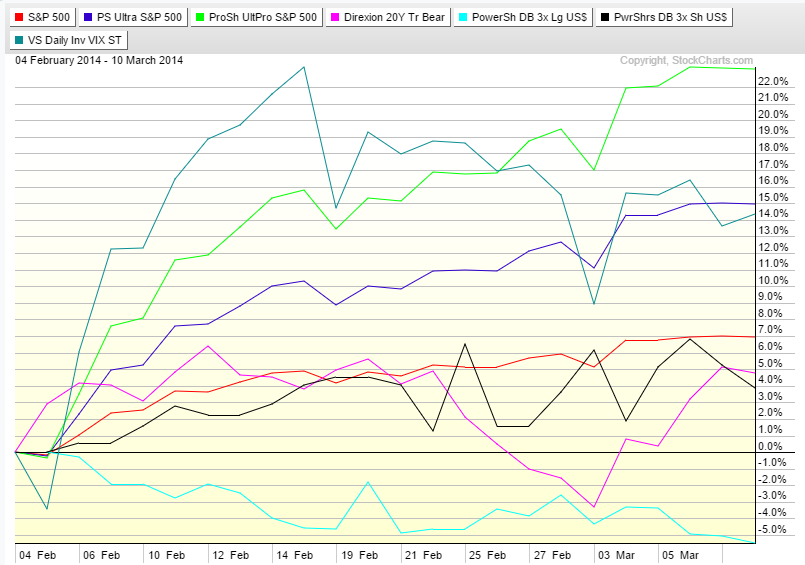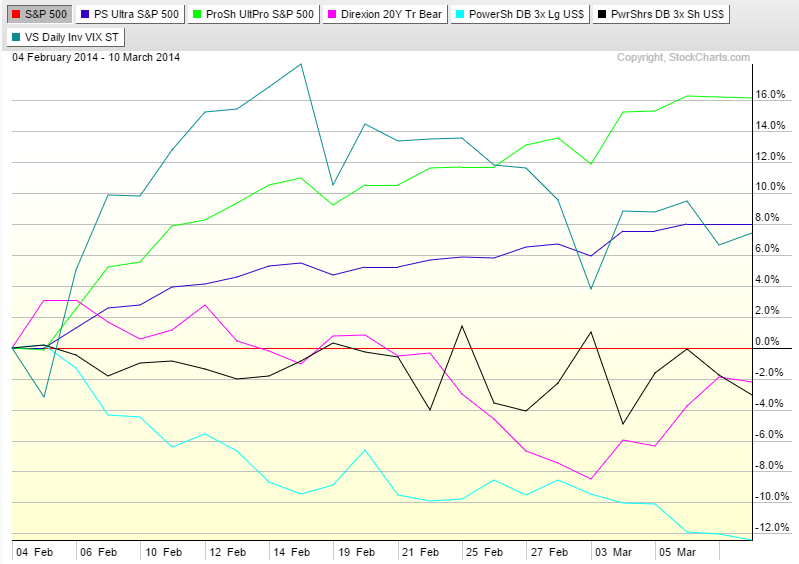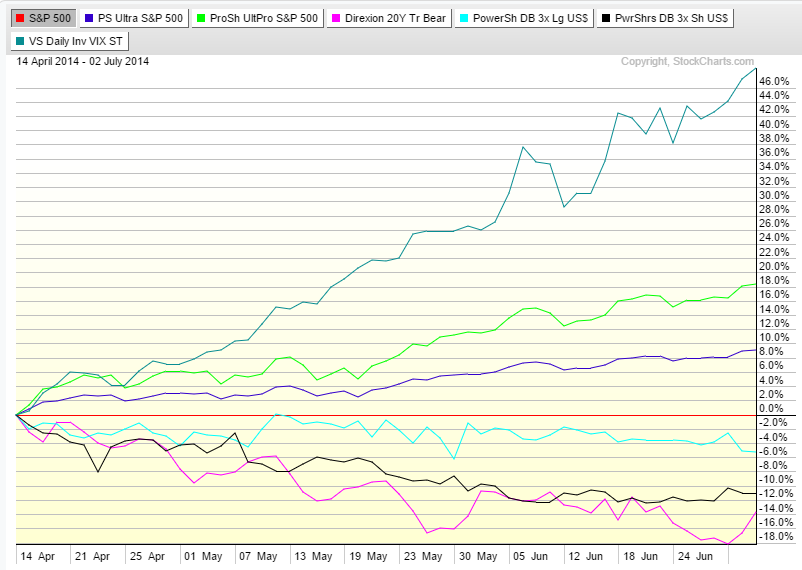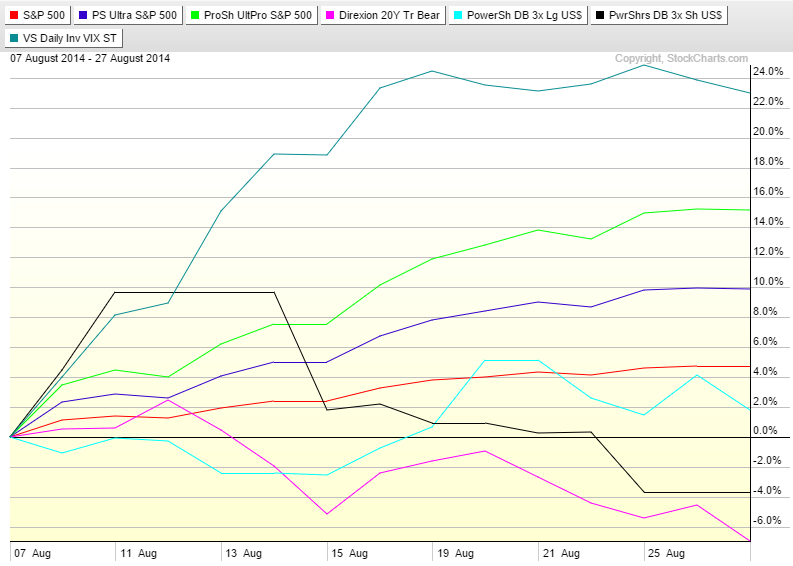Courtesy of Jean-Luc Saillard.
In my last post (Part 1 of this article), I looked at alternative ETFs that could be used as hedges against the corrections that we have seen during that long 2 year bull run. Looking at the results, it seems that for short (less than a month) corrections, a VIX ETF like VXX could actually be a viable candidate to hedge or speculate on the way down. Another alternative ETF was TMF, a long Treasuries ETF which banks on the fact that when markets go down, money tends to pack into treasuries viewed as safe instruments. In some cases, TMF even outperformed the usual hedging instruments like leveraged ETFs. There could of course be other factors at play since some of 2014 corrections were related to geopolitical events which are certainly positive for the Treasuries market. In times of uncertainty, nothing sounds safer than US Notes and Bonds. Dollar based ETFs were too inconsistent to be considered for hedging although they generally beat the market during these corrections.
In this post I want to look at instruments that should do well in the long periods where the market was up. The idea is once again to leverage your assets by investing in instruments that will beat the market by a large margin. I am not looking at derivative instruments like futures or options which can add leverage to already leveraged instruments, but the simple ETFs that can be bought and sold in any account including IRA and 401-K.
So what are my candidates for this study. First the standard leveraged ETFs (as they relate to the S&P 500):
SSO – A long 2x ETF tracking the S&P 500
UPRO – A long 3x ETF tracking the S&P 500
And some alternatives:
TMV – A 3x short Treasuries (20+ years) ETF
UUPT – A 3x long Dollar ETF
UDNT – A 3x short Dollar ETF
XIV – A short VIX ETF
Since the long Treasuries ETF did well during corrections, I want to look at the short Treasuries ETF during the rallies. The dollar ETFs were inconsistent as short instruments, but I will include them in this study as well in order to be thorough. And finally, I’ll look at XIV, a short VIX ETF since VXX did so well as a hedge.
Let’s look at our first rally of the year – February 4 to March 10. The first chart looks at absolute performance.
Colors are – Red (S&P 500), Blue (SSO, Green (UPRO), Pink (TMV), Turquoise (UUPT), Black (UDNT) and Gray (XIV).
The first conclusion is that once again, the leveraged ETFs perform as they are supposed to. The market is up about 7% and the 2x and 3x ETF are up 15% and 23% respectively which matches (or beats) their leverage ratio. Being long the dollar during this rally was not a good investment. But being short was not profitable either. I am afraid that this confirms the fact that the correlation between the markets and the dollar is not very strong. We’ll see what happens in the next periods.
Surprisingly, being short Treasuries was not a big winner either. It didn’t lose any money, but trailed the market toward the end of the period. Also something to be examined further. The big surprise again is the VIX ETF. Over the length of the period, it matches the return of the 2x ETF. But in the very short term, it’s beats every other instrument. It benefits from the the fact that the VIX generally spikes during corrections, but comes down very quickly. Since XIV is inversely proportional to the VIX, it does produce these quick spikes up as well.
The next rally we are looking at is the period between April 14 and July 2. Again, the first chart shows the absolute performance while the second one shows the performances relative to the market. The colors are the same as the previous set.
As with the previous set, the dollar ETFs are inconsistent. Not gaining much and not losing much. These instruments still don’t show much usable correlation with the market. Not much to say about the leveraged ETFs. The market is up about 8% in the period and the 2x ETF returns an expected 16% (a bit more) while the 3x ETF returns over 25%, slightly over the leverage ratio. This shows that during shorter periods, these ETFs do not suffer from the decay that they show during multi-year periods.
Surprisingly, the short Treasuries ETF is the worst performer. So again, not a very good choice if you are looking to outperform the market. But the biggest surprise is the VIX ETF. XIV is up over 50% in that 2.5 months period. It beats the 3x ETF by a large margin. Prolonged rallies without large corrections do erode the VIX considerably and XIV is a big beneficiary. Could the VIX ETF be a winner on the up side as well?
The next rally was shorter – about 3 weeks from August 7 to August 27. Based on what we saw in the first set, it should benefit the VIX ETF as the VIX crush is quick and violent.
Again, the charts show absolute and relative performances with the same color scheme.
And XIV doesn’t disappoint, beating the market by 18% in 3 weeks and even the 3x ETF by 8%. It sounds repetitive, but the leveraged ETFs still perform as expected while the dollar ETFs show inconsistency again. The biggest disappointment so far is the short Treasury ETF which doesn’t correlate as well with the market in rallies as the long ETF did during corrections.
The next period is a little longer and show the biggest gains in the market which should benefit the leveraged ETFs. Same chart parameters as before.
As expected, good performances from the leveraged ETFs. The long dollar ETF matches the market almost exactly but more a factor of external geopolitical influence than correlation. Being short the dollar was obviously a bad choice! Especially in a leveraged instrument. The short Treasuries ETF did not lose money and tracked the market nicely in the first 2 weeks but quickly lost steam probably also influenced by external factors.
And the winner is once again XIV, although not by as much as the last 2 sets but still significantly.
The last set we will look at are the last 2 weeks of 2014 where we had a nice little Santa Claus rally. Charting parameters are still the same.
The leveraged ETFs still perform as expected. And the long and short dollar ETFs return the exact same results as the last rally – the long ETF matching the market, while the short one losing a lot of ground. The Treasury ETF is very inconsistent, up big at some point but ending up about even.
This time, XIV doesn’t keep pace with the 3x ETF but still does better than than the 2x ETF. A bit surprising as shorter time periods would tend to benefit the VIX ETF.
Conclusions
As in the previous post, the dollar ETFs proved to be too inconsistent to be of any value hedging or leveraging the market. In a future post I will study how they correlate to the spot dollar and how an investor could profit from the leverage factors that these ETFs offer.
The biggest disappointment was the short Treasuries ETF. The long ETF did show some promise in 2014 but it’s also possible that it benefited from external events that boosted investments in US Treasuries. In a future post, I will also look at how these leveraged ETFs correlate to the underlying instruments.
The leveraged ETFs perform exactly or better than their leverage factor would indicate even on longer periods as decay doesn’t seem to have any impact. These instruments are the most predictable ways to leverage your assets during rallies. You know exactly what to expect.
The biggest winner in 2014 was XIV, the short VIX ETF. It did benefit from long rallies where the VIX lost significant percentages. Being long XIV during the rallies yielded a combined 142% during 2014. That’s a pretty good return no matter how you look at it! Of course, that implies a perfect timing which is impossible. But careful investment would still have yielded a nice return.
It’s difficult to draw definite conclusions yet as I have only studied these ETFs in one main environment – a relentless bull market. It would be interesting to see how these ETFs perform in the reverse conditions. Maybe the topic for another post!
In Part 3 to be posted next week I will look at timing methods that could have been used in conjunction with the 2 VIX ETFs (VXX and XIV) to produce the best possible return. It looks to me that allocating some of your assets to these 2 ETFs could be a smart choice.













